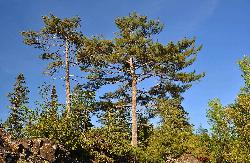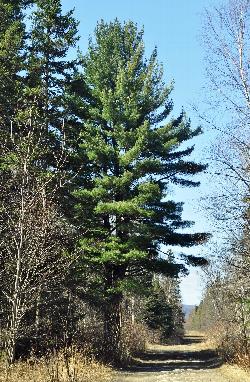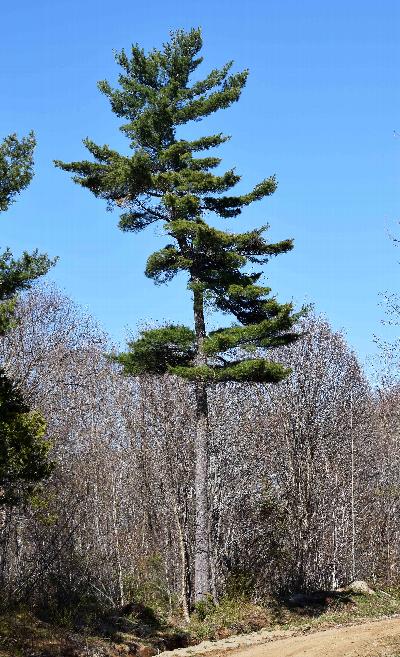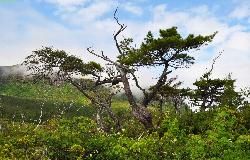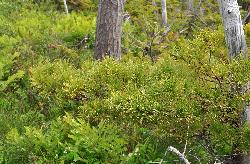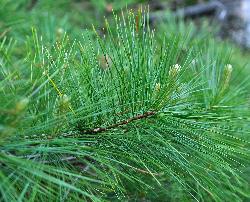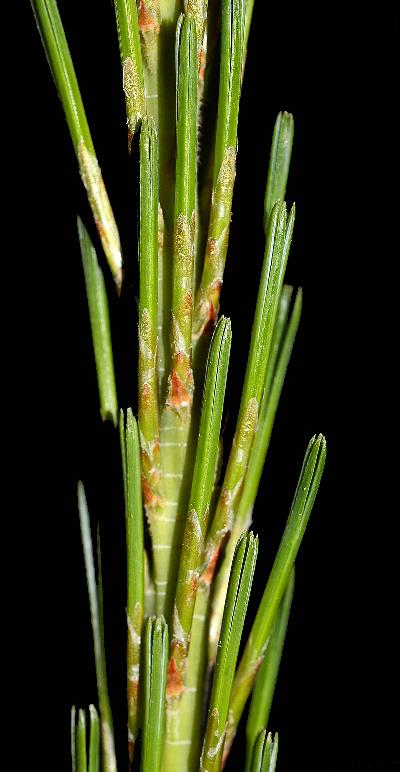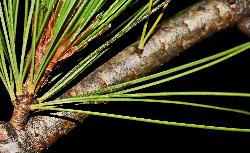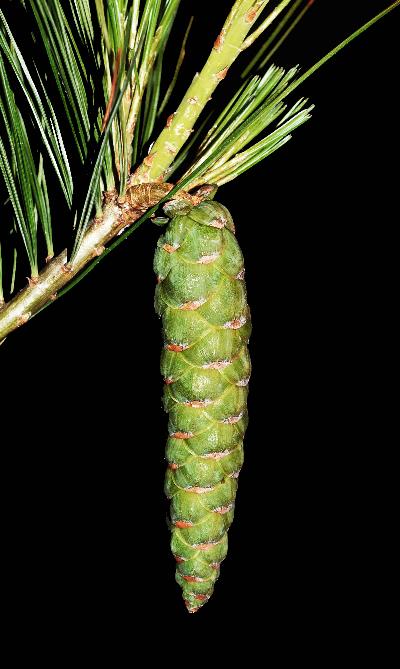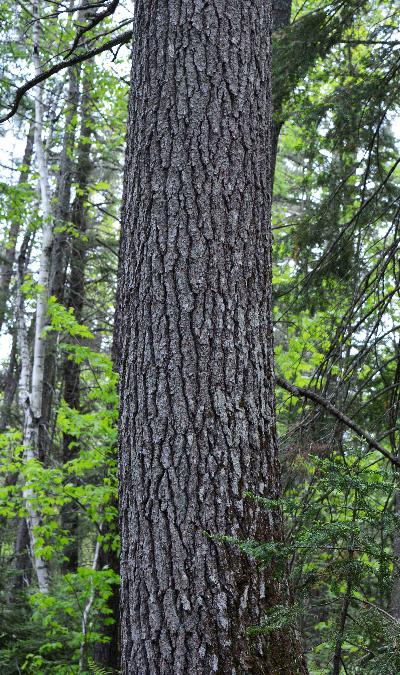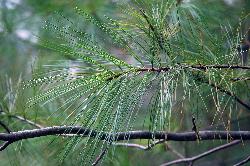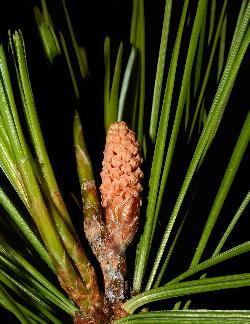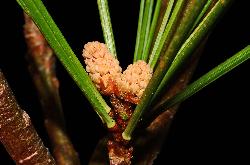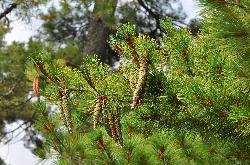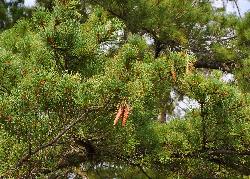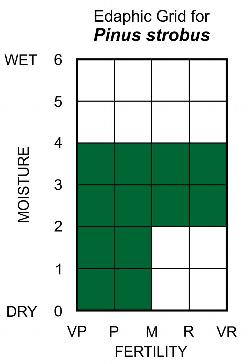Fr: pin blanc, pin strobus, pin du Lord Weymouth
Pinaceae - Pine Family
Note: Numbers provided in square brackets in the text refer to the image presented above; image numbers are displayed to the lower left of each image.
General: A long-lived (200–450 years), tall, evergreen tree [1–4], 30–60+ m tall, with a d.b.h. of 100 cm, an irregular often flattened crown, and whorled branches [5–6]. White pine is relatively windfirm and of intermediate shade-tolerance (Wendel and Smith 1990). Historically, white pine was heavily harvested in Newfoundland for use as sawlogs and ship masts from 1890 until the early 1900s when, combined with serious infestations of white pine blister rust (Cronartium ribicola J.C. Fisch.), population levels of white pine were reduced to very low levels. In 1999, plans were announced by the Dept. of Forest Resources and Agrifoods to ensure that white pine did not reach critically low population levels (Forest Resources and Agrifoods 1999), thus a ban on the harvesting of white spruce was announced and is still in effect.
Key Features:
- Needles occur in fascicles of 5, and are long, flexible, 5–15 cm long, and narrowly triangular in cross-section [7–10].
- Fascicle sheaths are deciduous after the first year [11].
- Cones are long and cylindrical, 8–20 cm long; cone scales have a slightly convex apophysis and a small terminal umbo [12].
White pine is classified as a soft pine (subgenus Strobus). In addition to the characters listed above, white pine shares the following traits of soft pines: needles have 1 vascular bundle, stomata occur mainly on the flat (inner) needle surfaces, cone scales have a small terminal umbo on each apophysis, cone scales are not sealed with resin after fertilization, and the wood is low in density, with a gradual transition from earlywood to latewood (Earle 2015).
Stems/twigs: Twigs are green and pubescent when immature, greenish-brown to light brown and glabrous when mature. Buds are narrowly ovoid, 4–5 cm long, scaly, slightly resinous, and pointed (acute). Trunks are usually very straight, except where extreme exposure causes wind pruning [4]. Mature trees have thick greyish-brown furrowed bark [13] and are moderately fire-resistant, but second-growth trees have thinner bark and are quite susceptible to damage by fire (Wendel and Smith 1990).
Needles: Evergreen, simple, sessile, and in fascicles of 5 needles [14]. White pine needles are long, slender, flexible, straight to slightly twisted, 5–15 cm long, dark green to bluish-green, sharply pointed (acute to acuminate) at the apex, and persist on the stem for 2–4 years. The needles are narrowly triangular in cross section, have finely serrulate margins, and parallel rows of stomates most visible on the straight (inner) needle surfaces. Each fascicle of young needles is bound at the base by a tubular sheath, 1–1.5 cm long, composed of overlapping rows of deciduous reddish-brown translucent bracts [10] that fall during the first year. Older fascicles of needles lack the sheath [11].
Reproductive structures/cones: Unisexual; trees monoecious, with separate male and female cones on different branches of the same tree. Male cones [15–16] are ellipsoid, 10–15 mm long, light brown to yellow, solitary, or with several rows of cones at the base of new growth. Pollination is by wind (anemophily) and male cones are shed after pollen is released. Immature female cones (conelets) are elongate, reddish-yellow, erect, solitary or clustered, and terminal on new shoots. Seed cones are pendant from a 2–3 cm long peduncle [12], narrowly cylindrical, 8–20 cm long, widest near the base and tapering gradually to the tip, and take 2 years to mature. Cones are green when young [17], maturing to light brown [18]; cone scale ends (apophyses) are slightly convex, with a small brown terminal umbo. At maturity, cone scales become woody and reflex slightly [19], releasing the seeds. The ovoid seeds are 5–6 mm long, with a pale wing, 1.8–2.5 cm long; dispersal is mainly by wind (anemochory) and unintentional dispersal by seed-eating (granivorous) birds and small mammals.
Ecology and Habitat: White pine occurs in insular Newfoundland south of the Northern Peninsula and is absent from Labrador. Throughout most of the Island, white pine has been harvested and regeneration is problematic due to white pine blister rust. It is fire resistant and large individuals still persist in remote areas that have not been harvested or on very steep slopes. It can grow on a wide variety of soils, but generally competes best on well drained sandy soils of low to medium site quality. White pine is the longest lived of our native conifers, attaining ages up to 450 years.
Edaphic Grid: See image [20]: the Edaphic Grid for Pinus strobus.
Forest Types: White pine is most frequently encountered on well drained, nutrient-poor to medium sites in the following forest types:
- Abietum typicum (Pleurozium-Balsam Fir Forest Subassociation)
- Kalmio-Piceetum typicum (Kalmia-Black Spruce Forest Subassociation)
- Piceetum marianae (Black Spruce-Moss Forest Association)
White pine can occur sporadically in any habitat including peatlands where it usually displays a stunted growth form.
Succession: It is doubtful that white pine ever formed pure stands in Newfoundland as it does in other parts of North America. Observations of areas that escaped harvesting and old residual stumps in extant forests suggest that it occurred with a density of about 10–15 trees/ha that exceeded 30–40 m in height and towered over the subordinate black spruce and balsam fir canopy. Because of its thick bark, mature white pines usually survive fire and the residual fire scars are often used to reconstruct local fire history. White pine is moderately shade-intolerant and usually needs fire to regenerate, although blister rust has considerably reduced survival in recent history.
Distribution: Eastern white pine is found across southern Canada, from Newfoundland west to northeastern and western Ontario and extreme southeastern Manitoba. In the United States, its range extends from Maine east to Minnesota and south, mainly along the Appalachian Mountains to northern Georgia (Wendel and Smith 1990).
Similar Species: White pine is similar in stature, habitat, and needle length to red pine (Pinus resinosa Aiton), but red pine has only 2 needles per fascicle and its cones are ovoid and much shorter, 4–7 cm long. Jack pine (Pinus banksiana Lamb.) is quite different and easily distinguishable from white pine by its short stiff needles, 2–4 cm long, which occur in fascicles of 2, and its serotinous asymmetric cones, which are 3–7 cm long.


